There are a lot of great free APIs out there that can be used for a variety of purposes. In this blog post, we’ll discuss three ways to find and use the best free APIs. Use your community One of the first places to look for a free API is in your own community. Has your church started a new programming initiative? Is there a new ministry that’s been formed within your church? Are there any other groups within your church that are doing something cool? Why not ask them to share any APIs with you? Asking for their help in sharing their API can do a lot of things: It helps you give something back to your community. It helps you build relationships with other like-minded people who are doing awesome things in your community. You may find out about an API you weren’t aware of that you can use in your own projects. Once you have a list of APIs, it’s time to take a look at them. Evaluate the API When you are evaluating your API candidates, it’s important to remember that not all APIs are created equal.

Table of Contents
Discuss three ways to find and use the best free APIs
There are many ways to find and use the best free APIs. Here are three of the most popular methods: 1. Use a search engine: Simply enter your topic followed by “API” into a search engine like Google, and you’ll likely find what you’re looking for. Once you find an API that looks promising, check out its documentation to see how it works and what data it returns. 2. Ask around: If you know other developers, ask them which APIs they like to use. You can even ask around on Twitter or Facebook. Be sure to use specific hashtags such as #API or #coding. 3. Read reviews: You can find reviews of APIs on websites like cnet.com, mashable.com, or lifehacker.com. Reading reviews can help you narrow down your search and choose the best free APIs for your app idea. Finding free APIs is easy because there are so many out there.
Search engines can be used to find relevant APIs
One way to find relevant APIs is to use search engines. Search engines can help you find APIs that are specific to the topic or keywords you are interested in. You can also use search engines to find general information about APIs and how they work. The following are some examples of search engines that you can use to find relevant APIs: Google https://www.google.com/search?q=api Bing http://www.bing.com/search?q=api Yahoo http://search.yahoo.com/search?p=api DuckDuckGo https://duckduckgo.com/?

API repositories like GitHub can provide a directory of available APIs
API repositories like GitHub can provide a directory of available APIs. However, not all APIs are created equal. Some are well-documented and easy to use, while others are more complex and require some coding knowledge to get started. When looking for an API to use, be sure to check the documentation and make sure it meets your needs before getting started. After you have found an API you’d like to use, the next step is to figure out how to access it. In many cases, this means installing some additional tools to help you connect to the free API and control the data that gets returned. For example, when working with APIs from Amazon Web Services (AWS), you need to install the AWS Command Line Interface (AWS CLI) and other AWS libraries in order to be able to access the data you need.
Some websites providing an API may also have documentation on how to use it
If you’re a developer, then you know how important APIs can be. They allow you to interact with other applications and data sources in order to get the information or functionality that you need. But where do you find the best free APIs? And once you’ve found them, how do you use them? Here are some tips for finding and using the best free APIs:
1. Look for a website that provides an API that matches your needs. For example, if you’re looking for weather data, then look for a weather API.
2. Look for documentation on the API you want to use. The documentation will often tell you the parameters that you need to send when making a request to the API.
3. Call the API and pass the parameters specified in the documentation.
4. Rerun the request until you get a response that contains some data. This data should be what you’re expecting from the API.
5. Read and understand the full documentation of the API before using it.

